

We explored Denmark for two weeks in late May 2022. We drove starting from Copenhagen and visited the cities and towns of Møn, Svardborg, Helnæs, Ribe, Jelling and up to Skagen. Then we headed back to Copenhagen with stops at Odense and Helsingør. We also visited the island of Æro and Frederiksborg Castle and Gardens.
Denmark is predominantly farmlands and sparsely populated. We did not see as many houses along the road as we saw in other countries we have driven in Europe. We did see a lot of wind turbines. Most Danes speak English. We only ran into a handful that did not.
Denmark is much more expensive than Spain, Italy and France and even slightly more expensive than the Netherlands. Denmark’s weather in late May was windy and can abruptly change from sunny to rainy. It was still cool (high 50’s to low 60’s at the end of May and into early June).
What is nice about Denmark is that there are free to use toilets unlike other European countries we visited. Parking seems to be easier too, especially outside of Copenhagen where buildings are more spread out with ample parking lots just like in the United States. We observed public drinking in Copenhagen where people were enjoying their favorite beverage while walking. They seem to like to party as well.
Last Minute Changes
We booked our first night accommodation in Ystad, Sweden so we can say we set foot in the land that gave us IKEA. To get to Ystad, we had to drive across the Øresund Bridge that connects Copenhagen, Denmark and Malmö, Sweden. So we thought we would just drive across it and drive back to Denmark the following day. However, during our last minute research prior to getting on the plane to Copenhagen, we found out that it would cost us 110 Euros just to cross the bridge and return.
On arrival at Copenhagen airport, we used its Wifi to call the Ystad accommodation owner to cancel our reservation for that night. Also, we were able to find some last minute accommodations at Zleep Hotel in Taastrup, about 30 minutes from the Copenhagen airport. It’s a good thing that we got all these squared away while at the airport as our T-mobile international data plan did not work in Denmark.
Møn
Møn was recommended to us by a Danish couple we met while staying in Amalfi, Italy. Møn is a small town on an island that is accessible by bridges. It’s less than two hours drive from Copenhagen airport. A few minutes after leaving Taastrup, we noticed farmlands of yellow blooming plants. We later learned that those were rapeseed plants which are cultivated in order to make rapeseed oil.


The main attraction is Møns Klint which is several miles of chalk cliff that slowly erodes to the Baltic sea. The cliff is about 400 feet above the water at its highest point. We started our explorations at the Møns Klint Geocenter. The Geocenter charges a small parking fee. The trails along the cliff are just a few steps behind the Geocenter.
Armed with a trail map from the Geocenter, we took the wooded path to the left (going north). Our plan was to walk the path for about a mile until we reached the wooden stairs that would take us down to the stony beach and under the chalk cliffs. Then we would turn around, walk along the beach and climb up the stairs that lead back to the Geocenter.
The trail on top of the cliff is all wooded. There was really no clearing where you could have a 180 degree view. The wooden stairs down to the beach were pretty solid, meaning it was being maintained as there were no rotten or unsafe sections. The water was calm at the stony beach. We just leisurely walked back and occasionally examined the face of the white cliff for what is being exposed due to erosion. Overall, we were not overly excited about what we saw at Møns Klint even though it was the first place we saw chalk white dirt.


Svendborg and Æro
We spent our next two nights at Svendborg and made a day trip to the island of Æro. From Møn, we took Hwy 9 (the south route) where we had to take a 45 minute ferry between the towns of Spodbjerg and Tars. The ferry cost was 271 Danish Kroner (DKK) or the equivalent of about $39 at the time.
We explored Egoskov Slot (castle) and Gardens before checking into our hotel at Svendborg. The castle charges 245 DKK or about $35 pp to tour its three story castle, gardens and museums. The castle primarily showcased trophy heads of mostly African wild animals along with antique furniture and other decorations. The gardens were predominantly sculptured evergreen shrubbery. There are several interconnected buildings (museums) that house collections of different vintage automobiles, bicycles and motorcycles. There was even a fire truck collection, Dolorian, and rescue helicopter. Last attraction were the suspended bridges that were about 20 feet above the ground and went from tree to tree.
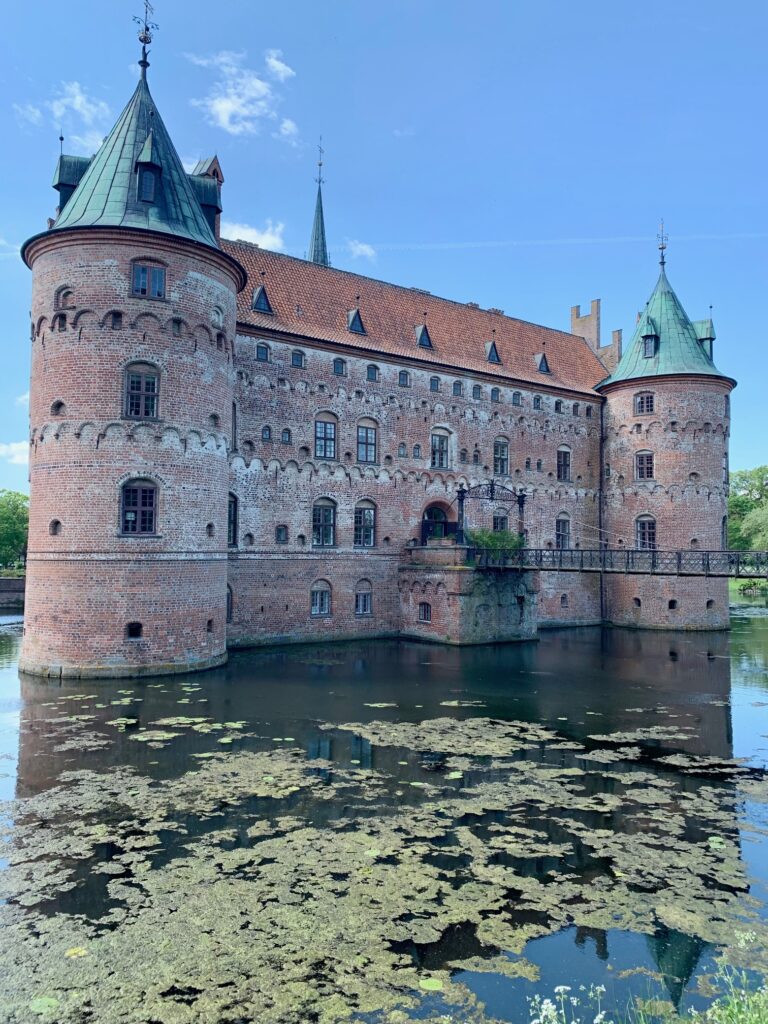



We really did not get a chance to explore the town of Svendborg except to just walk around the immediate area where we were staying which was the Best Western (now Hotel Svendborg).
The following day we took the ferry to the island of Æro. We bought our tickets on-line (including the car) the night before and boarded the 9:35 AM ferry. The ferry cost was about $54 round trip. We drove to the beach near Marstal to take pictures of the colorful beach houses. Then we walked around Marstal to see the colorful houses. Next was Voderup Klint where we walked along the beach and up on the cliff’s grassy area where we laid down and listened to the birds and the waves below. Next was the Soby lighthouse where it is surrounded by a scenic 18 hole golf course. The final stop was Æroskobing to see the more colorful beach houses and the colorful houses in the town. It was raining by the time we got to town but we walked around anyway. We only spent less than an hour in the town itself as the ferry was due to pick us up around 4:30 PM.
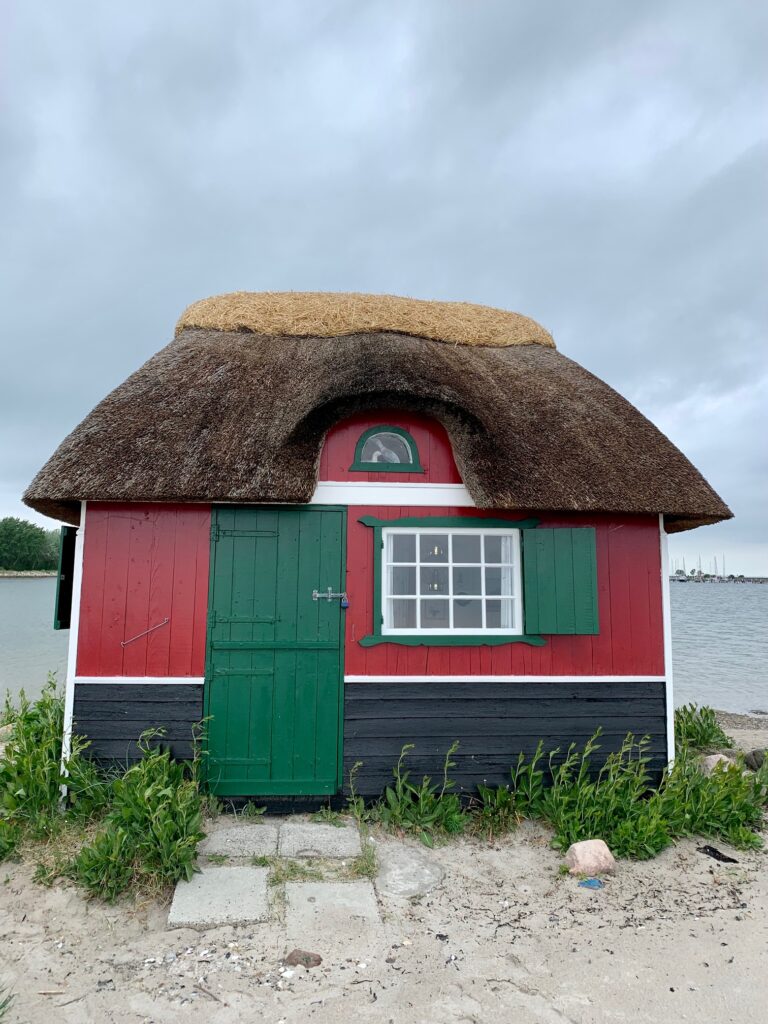

Helnæs, Ribe, Men by the Sea and Jelling
Before going to Ribe, we decided to do a hike in Helnæs, about 1.5 hours from Svendborg. We found a nature preserve with a lake and a little hill right beside the sea. We just laid back on the grassy hill, ate our lunch while the wind and sun hit our faces. It was a beautiful and relaxing day. We stopped by the Helnæs Fry or lighthouse before we drove to Ribe.


Ribe is the oldest town in Denmark so we took a stroll in its city center. It was a holiday. There were some people walking around but a lot of the local shops were closed. The huge Ribe Cathedral sits in the center of the old town. According to a local tourist info board, it’s one of the 100 most beautiful churches in the world.


Men by the Sea is about a 35 km drive from Ribe. Men by the Sea is free to the public and is a man made roadside attraction of four giant white male figures just sitting and facing the sea. It was fairly busy but not overly crowded. The parking lot was almost full. It was a very windy day also which kind of shortened our stay.


We visited Jelling because of its Viking heritage signified by burial mounds, rue stones and church. Together, they are a Unesco World Heritage site. There are two flat topped burial mounds. In between the two mounds sits a stone white washed churched and the two rue stones or inscription stones. One of the rue stones was erected by King Gorm in memory of his wife Thyra. The other larger stone was erected by King Gorm’s son, King Harald around the year 965 in memory of his parents. The most notable inscription on the larger stone is the figure of Christ which signifies the conversion of Denmark to Christianity. Not far from the rue stones is a local tourist information building which has a museum about Denmark during the Viking era.


Hiking near Hobro
We decided to do the circular 6.1 mile Bramslev Bakker Panoramaruten hike near the town of Hobro. The weather was partly sunny and perfect for hiking. We did the hike in a counter clockwise direction where we stayed up high and in the trees for most of the time. There were some views from time to time but it mostly took us through forest, farmlands and by a golf course.
The return trip was along the shore of Mariager Fjord and was easy walking. The hike is the first trail in Denmark that is certified as a Premium Hiking Route by the Deutsches Wanderinstitut (imagine that!). We finished the hike in about 3.5 hours.
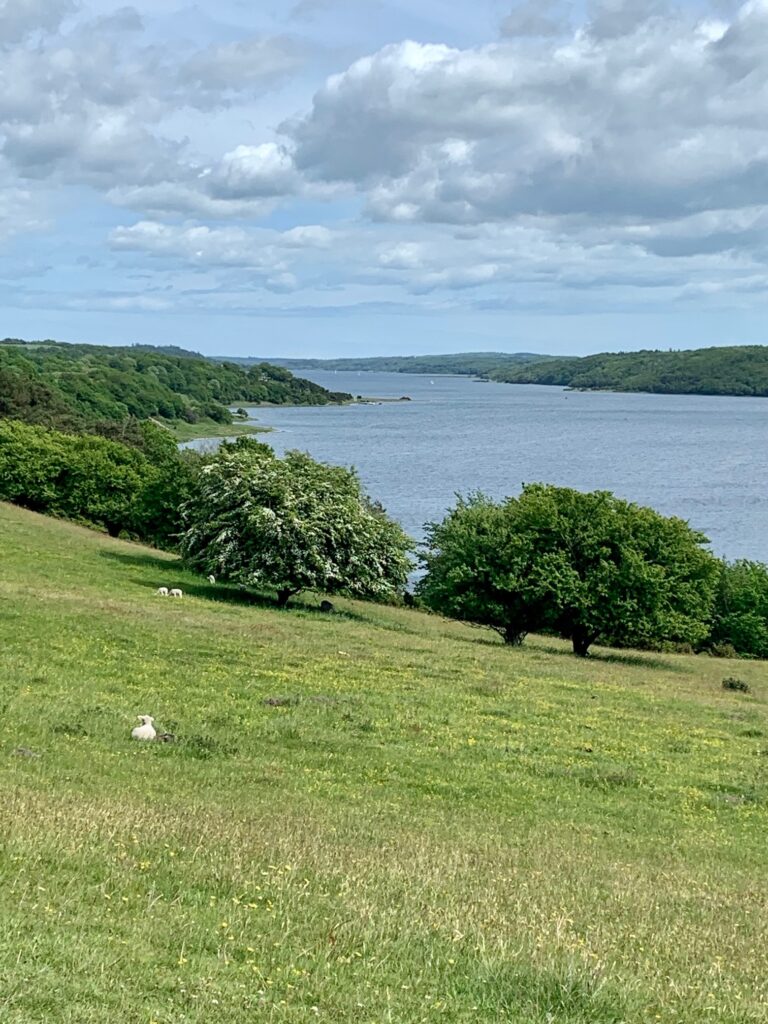

Grenen, Skagen, Råbjerg Mile and the Rubjerg Knude Fry
Grenen’s claim to fame are the two colliding seas. We boarded the Sandormen which is a cart pulled by a tractor (cost: 35DKK) that took us to the tip of the archipelago where the Skagerrak and Kattegat seas met. There we saw the waves of the two seas colliding. We took off our shoes and dipped in its frigid water.




At Skagen, we stopped by the Vippefyret which is a navigational light mechanism that looks like a trebuchet (catapult). Then we walked around Skagen and looked at its red roofed and yellow walled houses/buildings. There were not a lot of people in Skagen. Perhaps the season has not started yet as the parking lot ticket machine was wrapped in plastic and had a sign that seemed to indicate it would be operational on June 1st.




The Rabjerg Mile are shifting sand dunes that stretch for a mile or so. We walked up to the top of one of the dunes, spread our mylar ground cover and laid there just to take a pause from all the walking during the day. It reminded us of White Sands National Park in New Mexico although the color of dune in the Rabjerg mile is more beige than white.
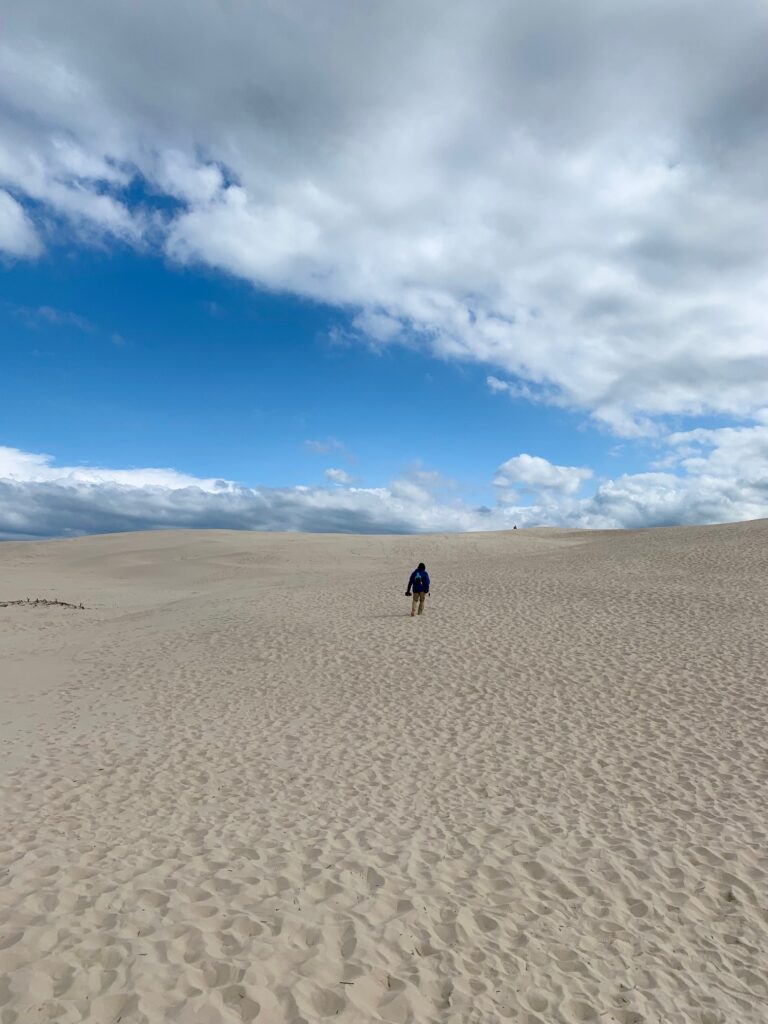

The Rubjerg Knude Fry is a historical lighthouse. What is interesting about this particular lighthouse is that it was moved about 70 meters inland back in 2019 to escape imminent collapse due to coastal erosion. Remnants of the original lighthouse foundation are still visible near the cliff’s edge. The lighthouse is no longer functioning but people can climb to the top. We were satisfied with the view from the base of the lighthouse and the surrounding dune as it sits about 100 feet or so above the beach below.


Odense, Frederiksborg Castle Gardens and Helsingør
We have seen so many European cities that they all seem to look alike. However, we decided to stop by Odense on our way to Slangerup to take a peek at the Hans Christian Andersen Museum. Andersen is a famous Danish author of fairy tales like Thumbelina and Little Mermaid. My wife just managed to see the outside of his house as we did not have time to tour his house and the museum.
We had to cross the toll bridge to get from Odense to Frederiksborg Castle Gardens. The bridge is part of highway E20 between Nyborg and Halsskov. It cost 250 DKK to drive through the toll bridge. We had to pay cash by inserting paper bills into an unattended machine. However, it was being monitored as we heard a lady on the machine’s speaker telling us where to insert the paper bills.
The garden of Frederiksborg Castle is huge. We walked around for an hour and we barely saw its entirety according to the garden map. Nice thing about the garden is that it’s free. However, the street parking on Batzkes Bakke street which dead-ends at one of the garden entrances was almost full.
Frederiksborg Castle charges 80 DKK admission fee per person. The castle is home to the Museum of National History, which presents 500 years of Danish history through a collection of portraits, history paintings, furniture and other artwork. The castle is huge compared to Egoskov. The castle has a unique chapel where it seems that every square inch is either decorated or has a mural. There is spotty Wifi inside the castle so one can listen to an audio narration about most of the displays through an app. The narrated displays are numbered which corresponds to the number in the narration app. We enjoyed this castle more than Egoskov.
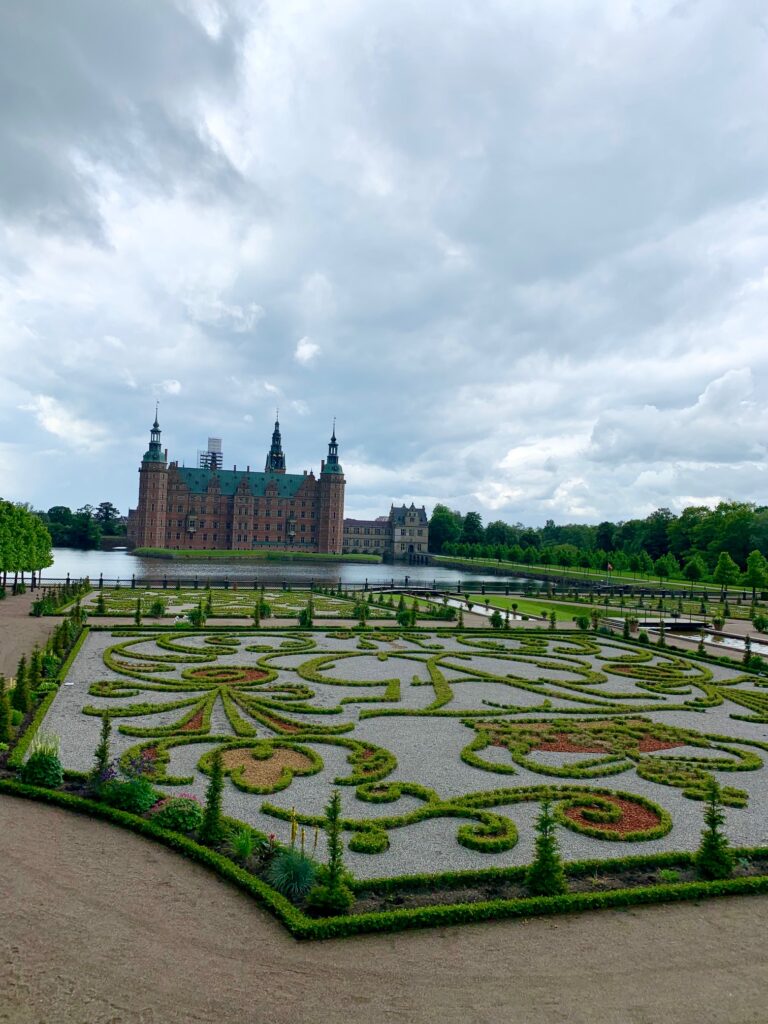



Helsingor is a small town with a pedestrian only street lined with shops. The queen of Denmark’s yacht was docked at the marina when we were there but we missed the queen’s appearance when she was out and about earlier. That was as close we got to aristocracy. Helsingor is also home to the Kronborg Slot which is the setting of Shakespeare Hamlet and is a UNESCO World Heritage site. We skipped exploring the inside of Kronborg Slot as we were castled-out having seen two castles already. So we decided to forgo the 145 DKK admission and instead just walked around the periphery of the castle where you can see the city of Helsingborg, Sweden a couple of miles across the channel.


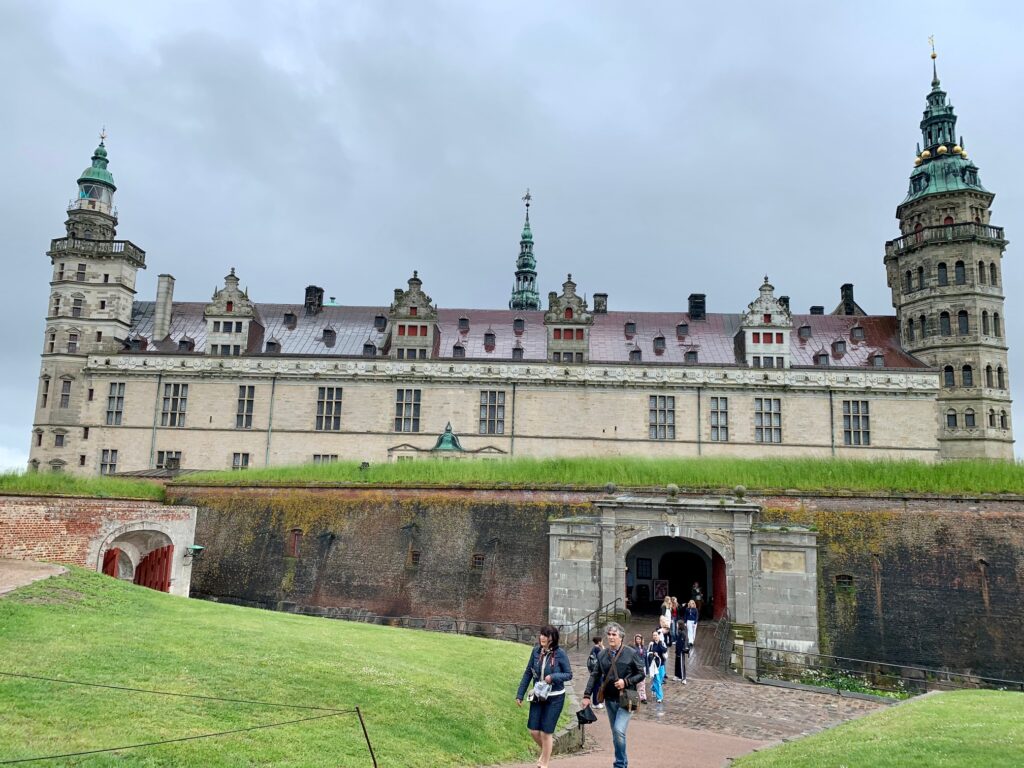

Copenhagen
We decided to explore Copenhagen on foot so we returned our rental car at the airport and just walked 15 minutes to our accommodation which was the Best Western. From the hotel, it’s a short 10 minute walk to the Kastrup tram station that would take us directly to the Copenhagen City Center.
We were lucky enough to have met a helpful and gracious Filipino who gave us one of his Reisekort cards to ride the tram. A Reisekort card is a loadable chip card that you tap before boarding and after leaving the tram. You tap the card to board so that the system can check if you have sufficient funds. The card needs to have a minimum amount of funds remaining for the machine to give a green light to board. I think it was around 60 DKK (don’t hold me to it as I am working from memory) per person. We were told by locals that there is a hefty fine if you forgot to tap your card. The fare is automatically deducted based on how far you travel when you tap the card after leaving the tram. There are some savings using the Reisekort card compared to just purchasing a ticket at the tram station even though you will not be able to zero out the card.
We got off at the Copenhagen City Center tram station. We visited Nyhavn which is the row of colorful buildings associated with Copenhagen. There are tour boats at Nyhavn which we said we will just do the following day (this was a mistake). We also saw Amalie Garden, the little mermaid statue, Frederiks Kirke, the Kastellet, Rosenborg Slot, The Round Tower, Tivoli (Amusement Park that we did not get in), Mermaid by Anne Marie Carl-Nielsen and Christiansborg Palace. By the end of the day, my wife’s I-watch had logged over 25,000 steps and our feet were aching.


On our second day of explorations we visited the Freetown Christiania which is a free spirited community where art is the main theme. There were plenty of murals and other outdoor paintings to gawk at. The locals seem to be all chilled. The rest of the day was spent watching people and walking the pedestrian only streets near The Round Tower.


If you want to ride the tour boats at Nyhavn, avoid the weekend in our opinion. We explored Copenhagen on a Friday and Saturday. There was hardly any line for the tour boats on our first day, which was a Friday. When we came back on Saturday, the line stretched for at least an hour, according to one of the tour boat operators.
Summary
Initially, we included Denmark on our places to visit so we can say that we were there. We even thought that we would probably cut our visit short as we might get bored because we did not find any jaw dropping scenery from our on-line research. We were pleasantly surprised by what we experienced. Its rolling landscape carpeted with blooming rapeseed plants, countless beaches, historical castles, friendly and laid back people and open areas more than made up for those missing jaw dropping natural wonders.
